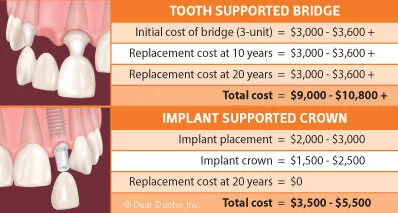Crowns and Bridges
When a tooth is weakened either from having root canal therapy or as a result of missing a significant amount of tooth structure, complete tooth protection may be recommended. Crowns act to protect remaining tooth structure and defend against further fractures by channeling biting forces down the centre of the tooth and away from vulnerable weakened parts. Without a crown, a tooth with a compromised structure risks a fracture through the centre of the tooth or one that shears off a large section of tooth down to the root surface. Large fractures such as these are usually “unrestorable”, meaning that they cannot be mended with a simple filling, so extraction may be the only option.
When a tooth (or two) are missing and the empty space is surrounded by strong healthy teeth, one option of tooth replacement is with a bridge. A bridge involves the use of the neighbouring teeth to anchor and support a false tooth that spans in between. Bridges are made to be a solid, single unit. It should be noted that a necessity of a bridge is cutting the adjacent teeth to create the support for the bridge. Whenever we prepare or cut teeth, we introduce a level of risk to an otherwise problem-free tooth.
Materials used for crowns and bridges:
Metal (stainless steel or gold)
Porcelain bonded to metal
All ceramic
Zirconia
Your dentist will review the pros and cons of each to help you decide which is best for your teeth and your budget.
Initially, the cost of a bridge vs an implant are nearly equal. When dental benefits cover part of the fee towards a bridge most are motivated to choose this option, but considering the long term costs, a bridge is actually the more expensive long term option.
Studies show that fixed bridges used to replace missing teeth increase the chance of developing tooth decay, gum disease and root canal problems on the supporting natural teeth.

